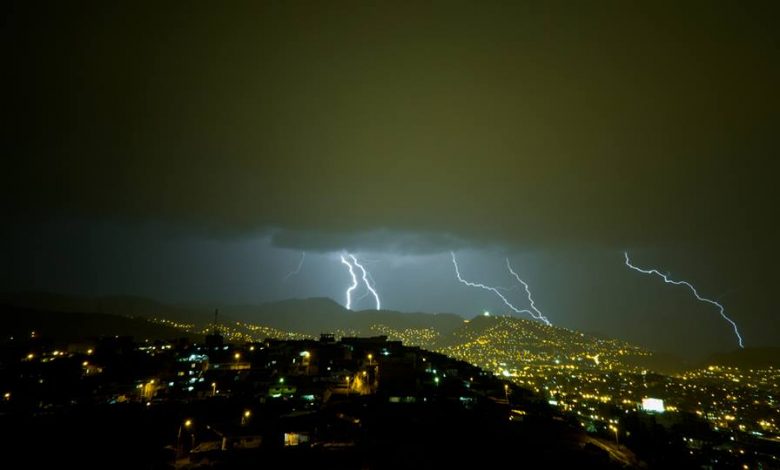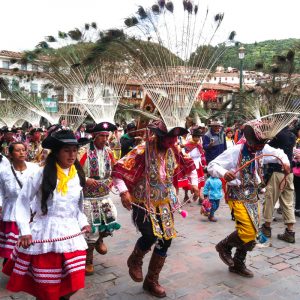Drama and the Child’s Image Thunder in Cuzco these Days

A clap of lightning, like a gash in the sky, tore the afternoon on Christmas Eve in Cusco, where the Plaza de Armas, the Main Square, was full of vendors and clients. They came for the annual Santuranitkuy Christmas Market. Following the burst of light and break of sound, the sky emptied a lake over the city as the streets filled to overflowing with runoff and people ran for cover.
This is Cuzco, where sky and land live in tension and mutual need. Without the water, the earth would dry and become unproductive, but the rain can destroy a market and the capital people have invested to have goods for the market, as well as send mudslides and floods. It can destroy fields and life. The lightning is known to strike flocks and people and kill them.
There is drama, like the colonial image of the winged angel, whether Gabriel or Michael, sword drawn, fighting endlessly with the serpent. While in mainstream Christianity it is a symbol of the victory of the divine over the demon, in the Andes it is a model of endless tension, like that between earth and sky.

On Christmas, in nearby Chumbivilcas, that tension is honored in the Christ Child, who many Incas adopted as their patron, their image, shortly after the conquest. For two days, yesterday and today, people gathered in Santo Tomás, the capital of the province to dance, sing, and fight. This is the one time of the year, when like lightning and thunder, their fists can break loose and pound those who cause them difficulty and grief.
The violence is ritualized and tamed, as the cosmic danger of constant war, becomes vested in two days of dancing, singing, eating, drinking, and, of course, fighting.

For many Christians, Christmas is a time of Peace. Pope Francis expressed it well in his call for everyone, athiests and believers to work for peace, though peace is ultimately a characteristic of heaven, the utopia of the post mortal existence.
Andeans tend to see things differently, even if Christian. This world is filled with divides and different interests and perspectives which makes for conflict, frustration, and tension. Peace is allowing it loose in a ceremony, a ritual battle, that then makes a dual reality: ordinary reality of it being unexpressed like the skies without rain and lightning and a time of conflict like when lightning races across the sky to a deep and frigthening drum roll while water pours like a river from the sky.
In the Christ Child, the people of Chumbivilcas invest that. In a thesis on the ritual battle called Takanakuy, meaning to give each other blows, Gustavo Adolfo Arias Díaz* cites the Chronicler Cristobal de Molina as stating that in December the two moities, halves, of Cuzco–upper and lower–would join in a ritual battle as a testing of strengths until the Inca would declare it finished. (p.22).

Arias also cites a tale about the origin of the church in Santo Tomás. It is said that while herding their animals local children saw two unknown children fighting on a flat piece of land near a cliff. As they came close, they strangers disappeared. So the locals told their parents about the happenings. The parents were able to confimr the happenings and declared them a miraculous revelation. They built an altar there to venerate the boys and called them The Niño de Santo Tomás and the Niño de Belen, in reference to the Christ Child. (pp 12-13)
Like the division of Cusco into two halves, this sets up a division for the area and enshrines within it the image of two children fighting. These children carry in themselves promises of growth and production, the central values of traditional Andean religiosity and most popular religiosity today.
On Christmas eve in Cusco, like the people of Santo Tomás who built an altar to fix their devotion to the two Christ children and keep them there (since in the Andes there are constant stories of saints and other holy figures leaving a community and going elsewhere in search of better devotion, and of towns luring figures from one another), people placed their own image of the Christ Child in altars in their own homes, their nativity scenes.
That night, they fell that that the child is born into their own manger. Many people welcome him with offerings of incense and prayer. They acknowledge that if pleased the child can give them gifts of good fortune and well being throughout the year. They want to make him happy.
They celebrate the time of his birth with a ritual meal and light fireworks to make noise, like the thunder in the sky that announces major storms. They may eat a rich chicken soup, along with hot sauce, and hot chocolate and panettone. Or they may follow the national trend of having a turkey dinner. The point is to bring the child (and his productivity) into the family as an important and welcome member. They eat and celebrate together.
People talk about how some Manuelitos, as the people of Cuzco call the Christ Child, go wandering–not unlike their own children. They say that the famous and miraculous Manuelito from the Temple of La Merced, called El Doctorcito–the little doctor–often goes roaming. When his attendants come to change his clothes they often notice that his socks are stained with dirt from his roaming.

On Christmas day, people take their image of the Emmanuel, the Manuel, to the various Churches to hear Mass. They take him home, so to speak, so that he will be content and filled with his natural relationship to divinity, to stay in the household and grace it. He will be visible until the Bajada de Reyes, the coming down of the Kings, the Wise Men, at which point the child will be put away with other holy things that each household keeps.
Not only did the people of Cuzco take their Manuelitos to Church on Christmas Day, people from the Department of Andahualyas brought their own images to Cuzco on the Day of his birth, as if taking them to Bethlehem. They came with costumed dancers and musicians and besides attending Church at the Cathedral and, maybe the old Temple of the Sun, the Church of Santo Domingo, they paraded through the streets and around the main square. I say maybe Santo Domingo because I did not see them do this, though a web page of their’s makes that central. They were busy, as was I, and so I was unable to speak with them much.
As the Qori Cancha, the Temple of the Sun, Santo Domingo is interesting. It housed the image of a child-sun, the morning, the bringer of the blessings of the day, and many writers see an association between that solar image, the Incas as ethnic group, and the Niño Manuel that so many people worship.
The pilgrims from Andahuaylas sang an ancient genre of song, called huaylía, associated with the Christ Child and this time of year. It is also associated with the people of that part of the Andes, where huayno morphs into huaylía and then to huaylas. The people of Chumbivilcas sing the same song style for Takanakuy. Here is part of a song quoted by Arías, which carries both images of the Christ Child and local children.
Child, do not be afraid
when a hail of stones falls.
Child, do not cry when
rivers of blood flow.
I am the brave Qorilazo (Golden rope).
He who wants a blow come out
with all sincerity
Waylia hia, waylia hia.
* Gustavo Adolfo Arias Díaz, Poder y Violencia en los Andes: a propósito de la costumbre del Takanakuy en la
Comunidad Campesina de Ccoyo, Cusco, Tesis de Maestría, FLACSO, Ecuador, Colegio Andino, Centro Bartolome de las Casas, Cusco, Peru.
Derecho y Sociedad




